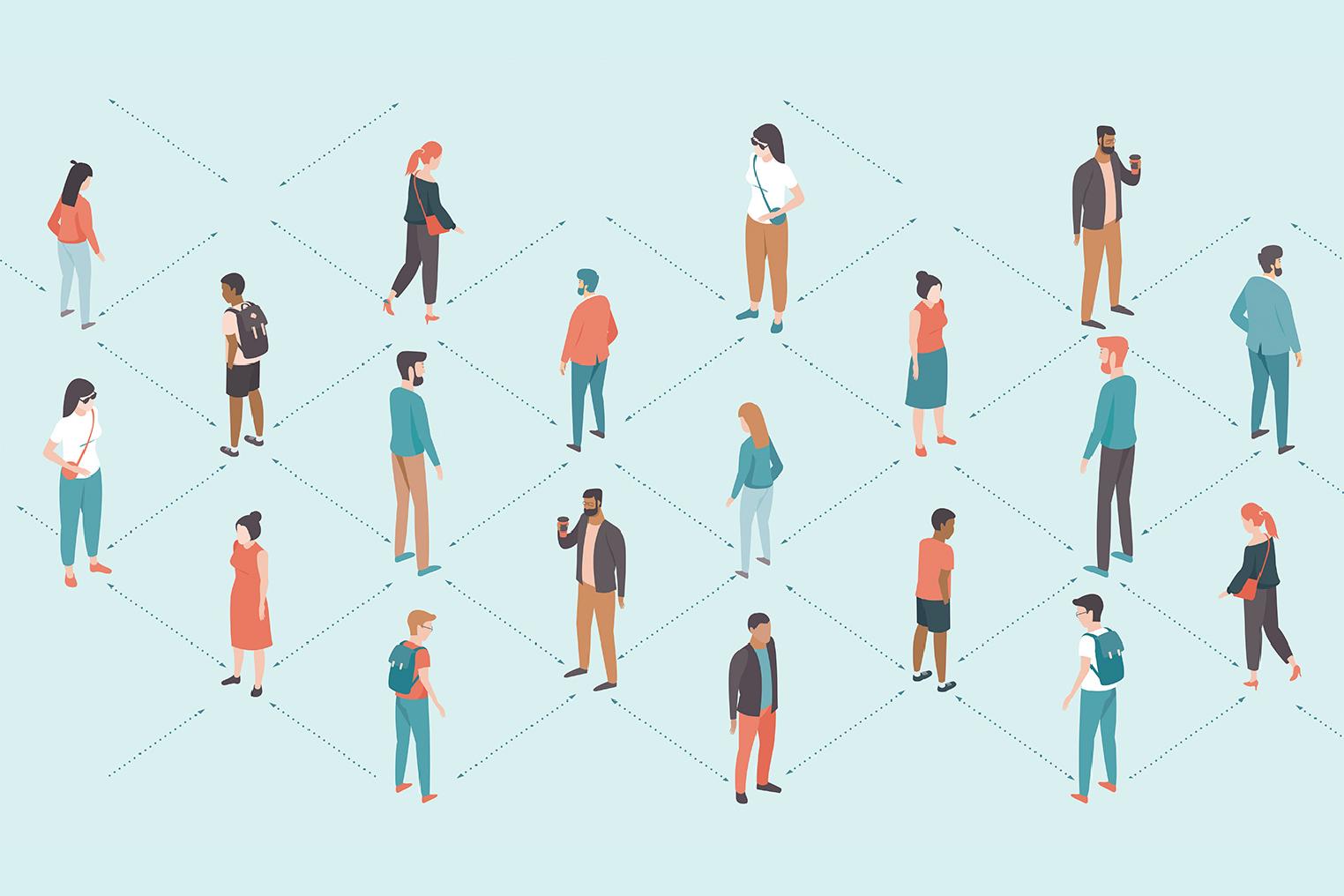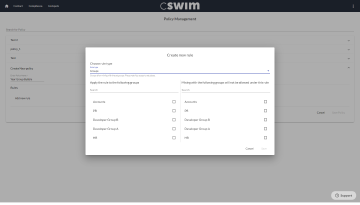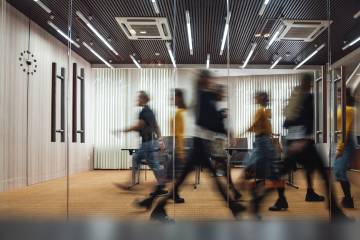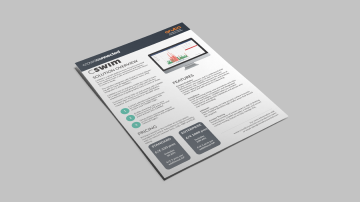Personnel tracking for workplace distancing and contact tracing

Personnel tracking for workplace distancing and contact tracing
Many of the new challenges that workplaces now face require some kind of personnel tracking. In particular, managing social distancing, and monitoring interactions between employees for contact tracing both require workers to be tracked.
Tracking technologies
Sophisticated camera systems with facial recognition can track the location of individual employees. But these systems are likely to be expensive to install and may suffer from general privacy concerns about any use of facial recognition.
If we rule out visually tracking employees, then tracking involves a device carried by each employee.
Bring your own device
One common approach is to use smartphones as the device that is tracked. Almost every employee brings their phone to work. This solution will almost certainly be cost-effective, but there are limitations.
Wearables
The second approach is to provide each employee with a wearable device that is tracked. When compared to solutions using smartphones, the cost of the hardware has to be taken into account. But there can be significant advantages, and the actual cost of the wearable may not be the most important consideration.
Tracking distance
If the only requirement is to measure contact between workers, then location is irrelevant. All that needs to be tracked is the distance between each device being carried by workers.
This is exactly what contact tracing apps using the Google / Apple contact tracing system are doing. The distance between any pair of smartphones is estimated very approximately using the strength of Bluetooth signals exchanged between the phones. Contact between two people is monitored, but it could be taking place anywhere in the world.
In the workplace, there are phone-based solutions and wearable based solutions that attempt to monitor the distance between people in this way.
Tracking location
Other technologies can monitor the location of each device carried by workers. The location of every worker can be very valuable data in reducing exposure risk in the workplace.
These technologies rely on exchanging a signal (which is often either WiFi, Bluetooth, ultrawideband, or ultrasound) between the carried device and a fixed point - a beacon or access point at a known location.
Depending on the accuracy of the location estimates, it can be possible to estimate the distance between two employees, without directly using signals between two carried devices.
Location accuracy
Some location technologies provide XY coordinate estimates. The accuracy varies widely from 10cm up to 20m or more. Whatever technology is used, there is always an overhead in setting up correctly scaled floor plans for the entire area to be covered.
Other systems don’t attempt to create XY coordinates. They are room-level, and just tell you which area or place an employee is in. These systems can often be simpler and cheaper to set up, as they don’t require accurate scale floor plans, or accurately mapped access points or beacons.
Tracking distance and location
Finally, some technologies will be capable of directly sensing the distance between two carried devices, and at the same time estimating the location of the devices.
How tracking data is used
Distance alerting
At one extreme, there are systems that don’t gather any data at all. A wearable device can flash and vibrate to indicate to the wearer that they are too close to another employee. But data about the contact - who was involved, how close they were, and for how long doesn’t necessarily have to be stored anywhere.
This provides helpful information to allow personnel to self-police a distancing policy. But that’s the extent of the system’s value.
Decentralised exposure notifications
The Google / Apple contact tracing system does store data about contacts, but locally on the smartphones concerned. This is designed to assure the greatest privacy. It allows contacts of an infectious person to be notified. But provides no additional value beyond that.
Centralised distance data
The next step is to upload distance-based contact data to a central system so that it can be analysed. This allows the workplace to ensure compliance with distancing rules.
However, without location data, there’s a limit to how useful this data is. You don’t know where contact is happening, just the people involved.
This can make it more difficult to ensure compliance in a ‘soft’ way - through nudges and targeted communication aimed at improving the culture. Instead, the only option may be policing - simply reprimanding individuals who breached distancing rules.
Centralised location data
The final step is to collect location tracking data centrally so that it can be analysed.
Exposure risk assessment
The goal of managing risk shouldn’t be to eliminate all contact. We want to bring employees back into the workplace precisely because face to face contact is essential. The goal should be to reduce all unnecessary contact. Knowing where contact is happening in the workplace can help manage exposure risk.
Space Utilisation
Are some areas too crowded, whilst other areas are under-utilised? Maximising space utilisation can help make sure that face to face interaction is happening, but with lower risk.
Unnecessary contact
Are there areas within the workplace where significant contact between employees is occurring, but with little value? Examples might be queuing for access control systems at entry points, or passing in crowded and congested corridors. Or taking elevators.
Maximum Occupancy Limits
Setting a limit on the minimum distance between two people isn’t the only way to reduce exposure risk. And it may not be the best way. Another approach is to set a limit on the maximum number of people who should be present in an area.
Reducing the permitted density is a first step in enabling people to maintain their distance. If there is more than one person per square meter in an area, they cannot maintain 2m distancing.
Complying with maximum occupancy limits may also be more intuitive for workers, compared to hard-to-judge distance-based rules.
It’s also worth remembering that distance-based rules are arbitrary. There’s ongoing debate about droplet spread vs aerosol spread. But in the end the goal must always be to reduce unnecessary contact as far as is possible.
It may also be easier to ensure compliance through cultural means - nudges and communication, instead of ‘policing’ - taking action immediately on non-compliance. Like a wrist-band buzzing the moment a worker steps within 2m of another.
Targeted Cleaning
Another side of COVID risk management that requires location data, rather than distance data, is targeting cleaning.
Regular surface cleaning can be targeted to hot-spots that are used by very large numbers of people.
Once infectious individuals have been identified in the workplace, post-infection deep cleaning can be targeted just at those places the individual visited whilst infectious.
Accuracy
Different techniques measure the distance between two employees, or their location in the workplace, with differing degrees of accuracy. As a very broad rule, the more accurate the measurement, the more costly the system. Thankfully the most accurate data is not always necessary.
If you want to measure the distance between two employees to enforce a 2m distancing rule, you need really accurate distance measurement. It’s no good if the buzzer on a wrist band goes off anywhere between half a meter and 4m away from your co-worker.
Don’t even try using smartphones for this. You only need to read the press about app-based contact tracing systems like the failed NHS app in the UK to see why. You need to use a wearable, and it needs to use a very accurate measurement signal - probably ultrawideband.
That starts getting expensive. And you need to question the value. There are probably better and cheaper ways for reducing workplace exposure risk.
Less expensive wearables can probably achieve accuracy of a few meters. That’s not much good for policing a 2m distancing rule. But it’s still useful for contact tracing.
Accuracy of location tracking also varies, from a meter right up to 20m or more. At this upper-end, it’s really a ‘place’ based system, telling you which area an employee is in, rather than true XY location.
Place level location tracking can still be used for exposure risk assessment, or maximum occupancy limits.
It can even be useful for contact tracing. Particularly as the emphasis moves from short-range droplet transmission to longer-range aerosol transmission that can infect anyone in the same room.
Widely available technologies
WiFi
WiFi networks can provide data on the approximate location of devices using the network. If users are logged into a corporate network, the location data can be matched to an individual employee or visitor.
Location accuracy can sometimes be down to a few meters. But in many cases the data should be considered room-level. No direct device-device distance measurement is possible, so contact between employees is inferred from their location.
To be effective close to 100% of people in the building need to be logged into the network. In practice, this may not be that hard to achieve. If BYOD is allowed in the workplace, almost all employees may already be logging in with a smartphone that is always carried with them.
This can be a very quick and economical route - using devices that employees bring with them, and existing infrastructure. Zero additional overlay.
It can provide the full suite of exposure risk assessment, occupancy limits, contact tracing, and hygiene targeting.
Phone Apps
Another common data gathering tool is mobile apps. Where there is already a workplace app with high update, this can be a good solution.
Direct device-device distance measurement may be offered. But caution is needed - it’s very difficult to make this work without the app permanently having user focus (‘being in foreground’). So the data may not be reliable.
Indoor Positioning Systems using WiFi or Bluetooth signals are available, and these can work better in the background. As with WiFi network data, contact can be inferred from the location data. Location accuracy can be down to a few meters.
The biggest issue with mobile apps is achieving close to 100% adoption. That doesn’t just mean 100% of employees downloading the app. They have to keep it downloaded, use it, and maintain the correct location permissions for it to do its job. Ensuring adoption on an ongoing basis is likely to be challenging.
Wearables
The final data-gathering option is wearables. But not all wearables are comparable.
- Some will have a battery life of only a day, and need recharging every night. Some will have a battery life of many months.
- Some will only monitor distance to other wearables, some will be able to monitor location too.
- Some will have an accuracy as good as 10cm. Some will be more like 10m accurate.
- Some will generate local alerts only, without storing any data. Some will store data, but will need a cable connection at the end of the day to upload it to a central system. Some will wirelessly upload data in close to real-time.
Wearables will usually be easier to manage than apps in the workplace - 100% adoption should be possible.
Privacy issues may also be easier to manage. Wearables can only track employees while they’re being worn. And will usually only track location whilst in the workplace. This is much easier to understand and accept compared to installing tracking software on the employees own smartphone.
Summary
Technologies are available to track the distance between employees, and/or their location. Both can help manage COVID risks in the workplace.
To enable exposure risk assessment, maximum occupancy limits, contact tracing and hygiene targeting, location tracking is needed, not just distance monitoring.
Apps running on employees’ smartphones can provide the data needed. But adoption rates are likely to be challenging.
WiFi networks can supply the required location tracking data at least at room level. Where there is an existing network covering the entire workplace, and where employees use their own smartphones to access the network, this can be an exceptionally quick and low-cost option
Wearables may provide better data, easier adoption and fewer privacy concerns. The most accurate systems can be very costly. But systems based on Bluetooth can provide exposure risk assessment, maximum occupancy limits, contact tracing and hygiene targeting at a surprisingly low entry cost.


